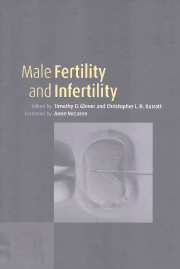Book contents
- Frontmatter
- Contents
- List of contributors
- Foreword by Anne McLaren, FRS
- Preface
- Acknowledgements
- Part 1 Biological perspectives
- 1 The evolution of the sexual arena
- 2 The role of sperm competition in reproduction
- 3 Sperm production and delivery in mammals, including man
- 4 The local control of spermatogenesis
- 5 Some misconceptions of the human epididymis
- 6 Transport of spermatozoa to the egg and fertilization success
- 7 Changes in human male reproductive health
- Part 2 Implications of the new technologies
- Index
2 - The role of sperm competition in reproduction
from Part 1 - Biological perspectives
Published online by Cambridge University Press: 09 August 2009
- Frontmatter
- Contents
- List of contributors
- Foreword by Anne McLaren, FRS
- Preface
- Acknowledgements
- Part 1 Biological perspectives
- 1 The evolution of the sexual arena
- 2 The role of sperm competition in reproduction
- 3 Sperm production and delivery in mammals, including man
- 4 The local control of spermatogenesis
- 5 Some misconceptions of the human epididymis
- 6 Transport of spermatozoa to the egg and fertilization success
- 7 Changes in human male reproductive health
- Part 2 Implications of the new technologies
- Index
Summary
Introduction
Why is it that a male chimpanzee (Pan troglodytes) ejaculates an average of 600 × 106 spermatozoa, whilst humans ejaculate fewer than 200 × 106 and the gorilla (Gorilla gorilla) 65 × 106 This question can be answered in a number of different ways, depending on one's perspective. A reproductive physiologist or clinician might answer by describing the mechanisms of sperm production, storage in the epididymal cauda and vas deferens and ejaculation. An evolutionary biologist, on the other hand, might answer by discussing the selection pressures that have been responsible for shaping chimpanzee reproductive anatomy and physiology and how individuals producing ejaculateds containing this number of spermatozoa left the most descendants. Both answers are correct, but they are concerned with different levels of analysis: mechanisms and function (or adaptive significance), respectively (Alcock & Sherman, 1994). The type of question we ask and how we go about answering it depend very much on our back ground training. Recently, though, behavioural ecologists have started to integrate evolutionary ideas and physiological mechanisms in a highly productive way (see Krebs & Davies, 1997) and this approach has been particularly successful in elucidating many of the factors which determine fertilization success.
Animal characteristics such as morphology, physiology and many types of behaviour, have evolved in response to both natural selection and sexual selection. Sexual selection is defined as the selection of any trait that enhances an individual's reproductive success relative to others in a population (Darwin, 1871; Andersson, 1994).
- Type
- Chapter
- Information
- Male Fertility and Infertility , pp. 18 - 33Publisher: Cambridge University PressPrint publication year: 1999

